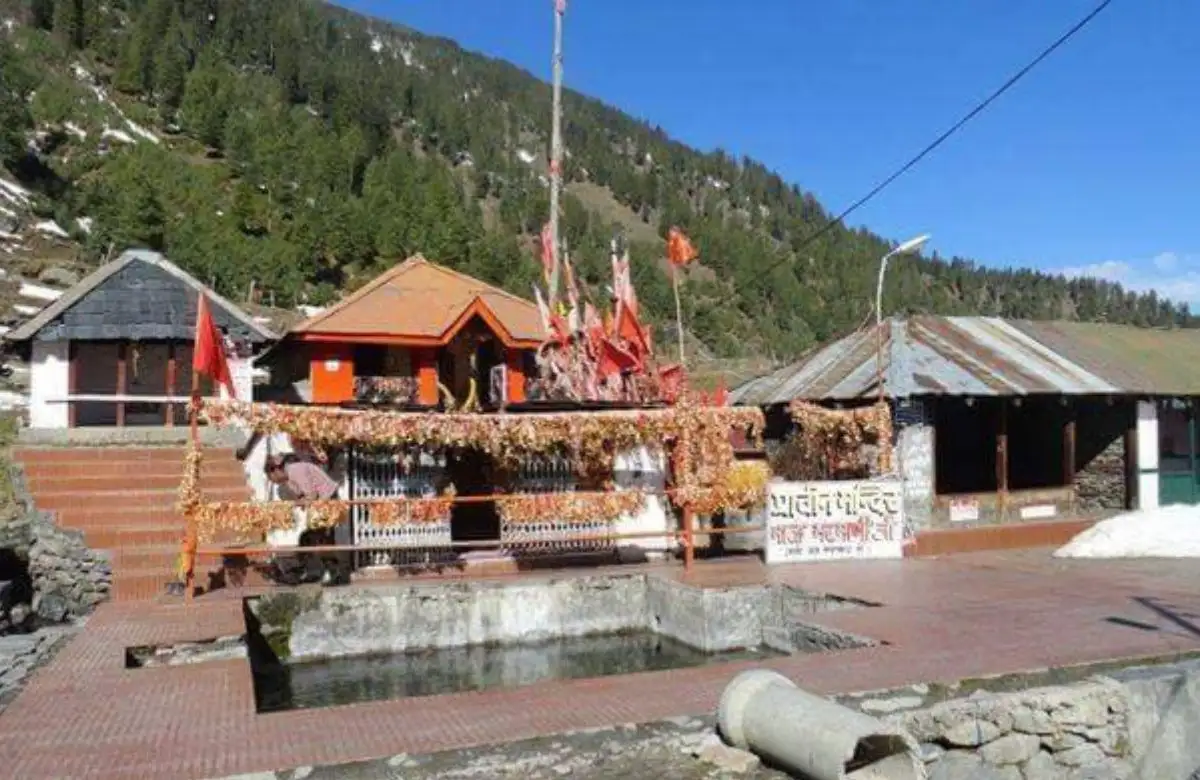Bharmani Mata Temple: Bharmour, Himachal Pradesh [Detailed Guide]

Get in touch with our Staff members and get discounted offers for your trip.


Bharmani Mata Temple is perched on a ridge approximately 4 km above Bharmour town in the Chamba district of Himachal Pradesh. Situated at an altitude of around 2,700 meters, the temple overlooks the scenic Budhil Valley. Dedicated to Goddess Bharmani—believed to be the daughter of Lord Brahma—the region was originally named Brahmpura in her honor.
According to legend, when 84 Siddhas arrived in Bharmour and began meditating near the current Chaurasi temple complex, Bharmani Mata became angry and drove them away. Later, Lord Shiva appeared and pacified her by granting a boon that every pilgrim en route to Manimahesh must first take a dip in her holy pond and offer prayers. Without doing so, their pilgrimage would remain spiritually incomplete.
Another folklore tells of the goddess stealing holy water from Lord Sandhol Nag, resulting in the origin of seven sacred streams that now flow beneath the temple. These streams also serve as a lifeline for the local water supply.
Bharmani Mata is regarded as the guardian deity of the Bharmour region and especially revered by the local Gaddi tribe. The temple is a vital stop during the Manimahesh Yatra, as it is believed that only after bathing in the temple's sacred pond and seeking blessings from the goddess can one begin the spiritual journey to Manimahesh Lake.
The temple is also the site of annual religious rituals, yajnas, and bhandaras (community feasts) organized by local devotees and pilgrims. Worship here is considered essential for those seeking divine blessings, fulfillment of wishes, and purification before the rigorous Manimahesh pilgrimage.
Holy Pond: A square-shaped sacred kund (pond) filled with icy waters from underground springs.
Shrine Structure: A simple yet spiritually potent structure surrounded by panoramic Himalayan views.
Basic Facilities: Shelters, kitchen areas, and resting spaces for pilgrims are available. During peak Yatra season, community meals are offered.
By Air: The nearest airport is Gaggal (Kangra), approximately 180 km away.
By Rail: Pathankot Railway Station is the closest major railway hub, around 160–180 km from Bharmour.
By Road: Bharmour is accessible by road from Chamba, which is 64 km away. Regular buses and taxis operate from Chamba to Bharmour.
By Trek: A scenic 2.5 to 3 km uphill trek through forests and meadows, beginning near the Bharmour helipad.
By Vehicle: A narrow and bumpy mountain road leads up to the temple for those unable to trek. Local jeeps or taxis may be hired for this route.
Summer (May to June): Ideal for a pleasant visit with mild temperatures and clear skies.
Monsoon & Yatra Season (August to September): This is the official Manimahesh Yatra period, marked by high pilgrimage footfall, especially around Janmashtami and Radhashtami.
Post-Monsoon (September to October): Good weather for trekking, but cold at night.
Winter (November to March): The temple remains closed due to heavy snowfall and inaccessibility.
Bharmour to Hadsar (13 km drive): This short drive takes you to the base village of Hadsar.
Hadsar to Dhancho (7 km trek): A moderate uphill trek through forest trails.
Dhancho to Manimahesh Lake via Gauri Kund (6 km): A steeper and more challenging trek that takes pilgrims past Gauri Kund (sacred for women) and Shiva Krotri (sacred for men) before reaching the divine Manimahesh Lake at an altitude of 4,080 meters.
This route typically requires 2–3 days and is well-marked with temporary rest camps, medical facilities, and langar services during the official Yatra.
An advanced trekking route suitable for experienced trekkers. The path goes through Kugti village, Kartik Swami Temple, Alyas Base Camp, and crosses the Kugti Pass before reaching Manimahesh. This trail is less crowded and more adventurous but takes 4–5 days.
Day 1: Reach Bharmour, visit Chaurasi Temple and Bharmani Mata Temple. Overnight stay.
Day 2: Drive to Hadsar and trek to Dhancho. Camp overnight.
Day 3: Trek to Manimahesh Lake via Gauri Kund. Offer prayers and return to Dhancho.
Day 4: Trek back to Hadsar and drive to Bharmour. Depart or stay overnight.
Visiting Bharmani Mata Temple and taking a dip in the sacred pond is mandatory before beginning the Manimahesh Yatra.
Carry sufficient warm clothing, even in summer, as temperatures drop significantly at night.
Start trekking early in the day to avoid afternoon weather fluctuations.
Wear sturdy trekking shoes and carry rain gear during the monsoon season.
Avoid alcohol and non-vegetarian food during the pilgrimage.
Respect local customs and environmental guidelines; do not litter in the sacred zones.
During Yatra season, free meals, medical aid, and tent accommodations are available along the trekking route.
Bharmani Mata Temple is not just a religious site but a spiritual gateway to one of the most sacred pilgrimages in the Himalayas—Manimahesh Kailash. Its divine pond, deep mythological roots, and tranquil surroundings make it a spiritually enriching experience. Whether you’re a pilgrim or a trekker, beginning your journey at this powerful shrine ensures a blessed and complete Yatra to the abode of Lord Shiva.